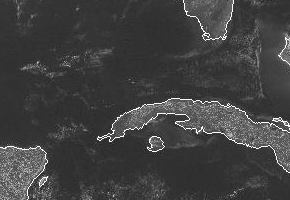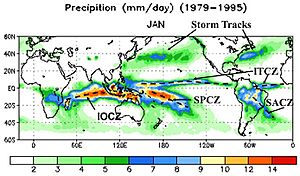Convergence zone facts for kids
A convergence zone in meteorology (the study of weather) is a place in the Earth's atmosphere where two main air flows come together. When this happens, the air has nowhere to go but up! This upward movement of air often leads to special weather conditions. As the air rises, it cools down, forming clouds and sometimes even precipitation like rain or snow.
Some convergence zones are huge, covering vast areas. These are linked to big weather systems like cyclones (swirling storms). Other convergence zones are smaller, creating anything from a few cumulus clouds to large thunderstorms. The opposite of convergence is divergence, where air spreads out.
Contents
Big Convergence Zones
One of the most famous big convergence zones is the Intertropical Convergence Zone (ITCZ). This is a low pressure area that circles the Earth near the Equator. It's like a weather belt around the middle of the planet!
Another example is the South Pacific convergence zone. This one stretches from the western Pacific Ocean all the way to French Polynesia.
The Intertropical Convergence Zone (ITCZ)
The ITCZ forms where the cool, dry Northeasterly and Southwesterly trade winds meet. These winds pick up moisture from the warm ocean. As they converge, the air rises. This rising air helps create many clouds and a lot of rain.
The low pressure area created by these winds acts like a vacuum. It pulls in cooler, dry air from high pressure areas (divergence zones). This creates a giant air circulation pattern called the Hadley Cell.
The position of the ITCZ changes with the seasons. It follows the Sun's position. When the Sun is directly over the Northern Hemisphere (around June 21), the ITCZ shifts north. When the Sun is over the Southern Hemisphere (around December 21), it shifts south.
Smaller Convergence Zones
Convergence zones can also happen on a smaller scale. These are called mesoscale convergence zones. They are often found in specific geographic areas.
For example, the Puget Sound Convergence Zone happens in the Puget Sound region of Washington, USA. Another one is the Mohawk–Hudson convergence in New York, USA. These smaller zones can also be linked to sea breeze fronts, where air from the ocean meets air from the land.
How Climate Change Affects Convergence Zones
Scientists have observed that the ITCZ has become more focused around the equator due to climate change. The rate at which air rises in the ITCZ changes daily. It's strongest when the Sun is highest in the sky (solar noon).
As global temperatures steadily rise, the convection (upward movement of air) in the ITCZ has increased. This makes the Hadley Cell circulation stronger.




